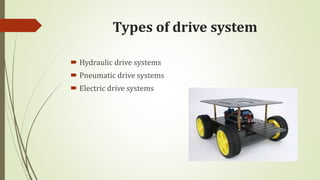Have you ever wondered what drives modern machinery to achieve the incredible feats seen daily? The drive system is essential to running your whole world, from the automobiles you drive to the industrial machinery that produces your commodities. Understanding these systems is not just for engineers; it’s for anyone curious about the technology that makes your daily life run smoothly.
Drive Systems are the backbone of mechanical movement in numerous applications, from simple household appliances to complex industrial machinery. They convert energy into motion, making tasks more efficient and automated. Let’s examine the various varieties and their special qualities, uses, and benefits.
Different Types of Drive Systems
- Mechanical
The different types of mechanical systems are as follows:
- Belt Drives
- Belt drives are among the most common mechanical driver systems, known for their simplicity and efficiency. They consist of a belt that transmits motion and power between pulleys. There are various belt drives, including flat belts, V-belts, and timing belts. Flat belts are used in applications where low-power transmission is needed, while V-belts and timing belts are suitable for higher power and more precise synchronization.
- Chain Drives
Chain drives use chains to transmit power between sprockets. They are known for their durability and ability to handle high loads. Unlike belt drives, chain drives do not slip, providing more accurate power transmission. They are commonly used in bicycles, motorcycles, and industrial machinery where high torque is required.
- Gear Drives
Gear drives use interlocking gears to transmit motion and power. They are highly efficient and can transmit high torque and speed with great precision. Diverse gear drives exist, such as worm gears, bevel gears, helical gears, and spur gears. Their respective uses depend on the direction of force and the speed reduction needed.
- Electrical
The diverse types of electrical systems are as follows:
- DC Motor Drives
A lot of applications that need accurate speed and torque control employ DC Motor Drive Systems. They are known for their simplicity and ease of control. DC drives can be classified into brushed and brushless types. Brushed DC motors are cost-effective and simple but require more maintenance due to brush wear. Conversely, because brushless DC motors don’t have brushes, they are more efficient and have a longer lifespan.
- AC Motor Drives
AC motor drives are prevalent in industrial and domestic applications due to their robustness and efficiency. They can be further classified into synchronous and asynchronous (induction) motors. Synchronous motors run at a constant speed regardless of load, making them suitable for applications where precise speed is crucial. Induction motors, however, are more common due to their ruggedness and simplicity. They are used in everything from household appliances to large industrial machinery.
- Servo Drives
Servo drives are used in applications needing exact control over acceleration, velocity, and angular or linear position employ servo drives. They are an essential component in robotics, CNC machinery, and other automated systems. Servo drives offer high precision and repeatability, making them ideal for complex motion control tasks.
- Hydraulic
The different types of hydraulic systems are as follows:
Hydraulic Pumps
Hydraulic pumps transform the mechanical energy into hydraulic energy by circulating hydraulic fluid throughout the system. They are critical in creating the pressure necessary for hydraulic systems to function. Common types include gear, vane, and piston pumps, each selected based on the required flow rate and pressure.
Hydraulic Motors
Hydraulic motors convert hydraulic energy back into mechanical energy. They are often used in heavy machinery such as excavators, cranes, and other construction equipment. Hydraulic motors provide high torque at low speeds, making them ideal for applications requiring robust, controlled motion.
Hydraulic Cylinders
Hydraulic cylinders produce linear motion and force by converting hydraulic energy into mechanical movement. They are commonly used in lifting, pushing, and pulling applications in various industrial and construction machinery. Hydraulic cylinders are prized for their ability to generate significant force with high precision.
- Pneumatic
The different types of pneumatic systems are as follows:
Pneumatic Actuators
Pneumatic actuators use compressed air to produce motion. They are known for their rapid response times and simplicity. These actuators are commonly used in applications requiring quick, repetitive motions, such as assembly lines and packaging machinery.
Pneumatic Motors
Pneumatic motors convert compressed air into mechanical energy to produce rotary motion. They are used in tools like pneumatic drills and wrenches, as well as in industrial automation, where explosion-proof operation is required.
Pneumatic Cylinders
Pneumatic cylinders produce linear motion through the force of compressed air. They are used in various applications, including clamping, positioning, and lifting. Pneumatic cylinders are valued for their cleanliness and speed, making them suitable for food processing and pharmaceutical industries.
Gaining a greater understanding of the various drive system types will help you appreciate the technology that powers many elements of people’s everyday lives. From the mechanical simplicity of belt drives to the precision of servo systems, each type of drive system has unique advantages and applications. So, next time you see a machine in action, you’ll better understand the intricate systems behind the scenes at work.



